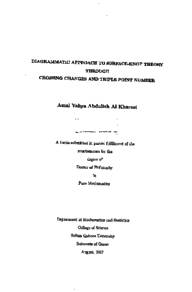Document
Diagrammatic approach to surface-knot theory through crossing changes and triple point number
Publisher
Sultan Qaboos University
Gregorian
2017
Language
English
Subject
English abstract
Abstract
ncer
This thesis is primarily concerned with two main questions that refer to the knottedness problem on surface-knot theory. The first question is: Suppose A
and A' are surface-knot diagrams of equivalent non-trivial surface-knots F and F',
respectively. Assume that a trivial surface-knot is obtained from A by crossing
changes. Can we obtain a trivial surface-knot from Aby making suitable crossing
changes as well? The second question is: What is the minimal triple point number
for orientable surface-knots? We introduce the following contributions related to
11
Yves
the first question: A crossing change operation along double point curves of surface-knot diagrams is defined. We show that any surface-knot diagram has a union of exchangeable double curves. We define a family of surface-knots called du-exchangeable surface-knots and a special sequence of surface-knot diagrams called a t-descendent sequence. We prove that for a du-exchangeable surface knot, there exists a finite t-descendent sequence of surface-knot diagrams, each of
e
which can be unknotted by the crossing changes. As an application, an invariant
for du-exchangeable surface-knots called the du-exchange index is defined. The
answer to the second question is well known for 2-knot case. We estimate the
lower bound for triple point number for genus-one surface-knots. In fact, we show
that there is no orientable surface-knot of genus one with triple point number two.
To prove this result, we use Roseman moves and the oriented intersection number
eman Moves
1 Numi
of simple closed curves in the double decker set. Indeed, we use diagrammatic
methods to discuss the two questions under consideration
Member of
Resource URL
Arabic abstract
ملخص البحث
تهدف هذه الرسالة البحثية لتسليط الضوء على مسألتين مهمتين و المرتبطتين بمسألة العقد في نظرية السطوح المعقدة. السؤال الأول: افترض أن ( أن 'A هما صورتان لسطحين معقدين متماثلين. نفترض أن سطح غير معقد ينتج من 4 عن طريق تغيير معلومات نقاط التقاطع. هل من الممكن الحصول على سطح غير معقد من و عن طريق تغيير معلومات نقاط التقاطع أيضا؟ السؤال الثاني: ما هو الحد الأدني لعدد النقاط الثلاثية للسطوح المعقدة الموجهة. نقدم المساهمات التالية لحل المسألة الأولى: نعرف عملية تغيير معلومات نقاط التقاطع و نثبت آن أي سطح معقد يمكن تغيير معلومات نقاط التقاطع لبعض من منحنياته المزدوجة. كذلك نعرف عائلة من السطوح المعقدة نسميها du - exchangeable و سلسلة خاصة من الصور للسطوح المعقدة نسميها t - descendent نحن نثبت أن اي duexchangeable سطح معقد لديه descnendent سلسلة من الصور، كل واحد فيها يمكن تحويله الى سطح غير معقد عن طريق تغيير معلومات نقاط التقاطع. كتطبيق لهذه النتيجة، نقدم ثابت للسطوح المعقدة duexhangeable. جواب السؤال الثاني معروف في حالة 2knot. نحن نقدر الحد الأدنى لعدد النقاط الثلاثية للسطوح المعقدة أحادية genus. في الحقيقة، نحن نثبت أنه لا يوجد سطح معقد موجه أحادي genus بعدد النقاط الثلاثية مساوي لاثنين. لاثبات هذه النتيجة، نستخدم Roseman moves و عدد نقاط التقاطع الموجه للمنحنيات المغلقة والبسيطة في مجموعة الطوابق المزدوجة. في الواقع، نحن نستخدم الصور لمناقشة المسألتين المراد دراستهما۔.
تهدف هذه الرسالة البحثية لتسليط الضوء على مسألتين مهمتين و المرتبطتين بمسألة العقد في نظرية السطوح المعقدة. السؤال الأول: افترض أن ( أن 'A هما صورتان لسطحين معقدين متماثلين. نفترض أن سطح غير معقد ينتج من 4 عن طريق تغيير معلومات نقاط التقاطع. هل من الممكن الحصول على سطح غير معقد من و عن طريق تغيير معلومات نقاط التقاطع أيضا؟ السؤال الثاني: ما هو الحد الأدني لعدد النقاط الثلاثية للسطوح المعقدة الموجهة. نقدم المساهمات التالية لحل المسألة الأولى: نعرف عملية تغيير معلومات نقاط التقاطع و نثبت آن أي سطح معقد يمكن تغيير معلومات نقاط التقاطع لبعض من منحنياته المزدوجة. كذلك نعرف عائلة من السطوح المعقدة نسميها du - exchangeable و سلسلة خاصة من الصور للسطوح المعقدة نسميها t - descendent نحن نثبت أن اي duexchangeable سطح معقد لديه descnendent سلسلة من الصور، كل واحد فيها يمكن تحويله الى سطح غير معقد عن طريق تغيير معلومات نقاط التقاطع. كتطبيق لهذه النتيجة، نقدم ثابت للسطوح المعقدة duexhangeable. جواب السؤال الثاني معروف في حالة 2knot. نحن نقدر الحد الأدنى لعدد النقاط الثلاثية للسطوح المعقدة أحادية genus. في الحقيقة، نحن نثبت أنه لا يوجد سطح معقد موجه أحادي genus بعدد النقاط الثلاثية مساوي لاثنين. لاثبات هذه النتيجة، نستخدم Roseman moves و عدد نقاط التقاطع الموجه للمنحنيات المغلقة والبسيطة في مجموعة الطوابق المزدوجة. في الواقع، نحن نستخدم الصور لمناقشة المسألتين المراد دراستهما۔.
Category
Theses and Dissertations

